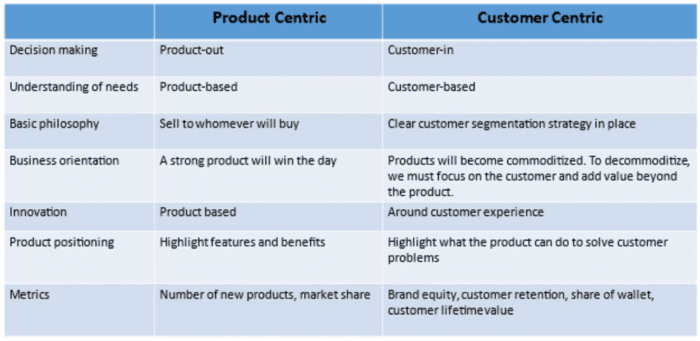Why Your Business Must Become Customer-Centric

We’re undergoing a digital revolution that is reshaping so many aspects of the way we work and do business. And increasingly, in this new environment, success in business is driven by the customer experience. The companies that get it right, like Apple and Tesla, are thriving – and those that don’t are losing customers and market share.

These are some of the core issues that lie at the heart of Schulich’s Centre for Customer Centricity. Established three years ago, the Centre is a leading hub for the creation, application, and dissemination of knowledge related to making an organization customer-centric. The Centre also provides organizations with customized consulting projects that include detailed customer analysis and practical recommendations.
In this month’s column by Ajay Sirsi, Director of Schulich’s Centre for Customer Centricity, we look at some of the ways the Schulich Centre is helping companies boost profits and build customer loyalty through a business philosophy built around solving customer problems and enhancing the customer experience.
Best,

Detlev Zwick, PhD
Dean, Tanna H. Schulich Chair in Digital Marketing Strategy
Schulich School of Business
Why Your Business Must Become Customer-Centric

The goal of Schulich’s Centre for Customer Centricity is to teach organizations how to become customer-centric. We achieve this goal through education, research, and MBA experiential learning projects where students work on consulting assignments for companies.
The research conducted by the Centre shows that customer-centric organizations are far more successful than product-centric ones. This is because a product-centric orientation is inward-looking (read: myopic), while a customer-centric orientation is outward-looking (read: farsighted). Business history teaches us that product-centric companies eventually die while customer-centric organizations enjoy longevity.
The Centre recently conducted a survey to uncover the main barriers to making an organization customer-centric. The number one finding was no standard definition of the term. In other words, confusion about what this term means.
Customer Centricity is not the same as Customer Focus
While the concepts of customer focus and customer-centricity are related, you should not use them interchangeably. A customer-centric organization is customer-focused, but a customer-focused organization is not necessarily customer-centric. Let me explain by delving deeper.
To understand customer-centricity, we have to contrast it with a product-centric orientation. The table below highlights the key differences.

In a customer-centric business, all decisions start with the customer. Product-centric organizations develop the product first, then try to convince customers to buy. Customer-centric companies start with what problems the customer is attempting to solve and the value the customer seeks. They then work to design offerings to solve customer problems.
Product-centric businesses will sell to anyone who wants to buy. This mistake saps profitability as not all customers are equally attractive to serve. On the other hand, customer-centric companies have a clear customer segmentation strategy. They know who their target customers are. Importantly, they know who is not their target customer. They do not try to be all things to all customers. The recent supply chain challenges have highlighted the importance of segmenting customers: faced with product shortages, whom will you serve first?
Product-centric companies eventually die as product categories become commoditized and irrelevant. A customer-centric company understands this very well. It decommoditizes by adding value to the customer beyond the product, focusing on the totality of the customer’s experience.
Customer-centricity means constantly thinking about our customer’s pain points and offering beyond-the-product value propositions to help them mitigate them, such as high operating costs, minimizing downtime, and maximizing uptime. Therefore, a customer-centric company understands customer needs beyond basic needs (quality, on-time delivery, after-sales service, low price).
The sales and marketing teams in a product-centric business highlight features and benefits of the product. Such positioning in the marketplace makes it difficult for them to differentiate themselves from their competitors, who are also touting the features and benefits of their products. In contrast, the sales and marketing teams in a customer-centric business focus on how their offerings add value to the customer by increasing revenue or decreasing costs.
The final point about customer-centricity is on metrics. A customer-centric company goes beyond product-centric metrics by measuring brand equity, customer satisfaction, customer retention, the share of wallet (what percentage of the customer’s order book we have), and the customer’s lifetime value (how much is a loyal customer worth to us?). Two examples illustrate this.
A manufacturer of specialty wiring was drowning in a sea of sameness. All competitors were promoting the superiority of their products. The fight for market share was intense, with frequent price discounts to secure a deal. The Centre showed the customer that a product-centric approach – with its corresponding focus on market share – was futile. A customer-centric approach would ensure success. This customer is now enjoying higher profitability.
How do we accomplish such results at the Centre? It’s part of the MBA students’ learning journey through experiential education and my coaching at every step of the way.
In the case of the specialty manufacturer, the students first had to uncover how customers made buying decisions. This required deep, structured conversations with key personnel. Not surprisingly, they found that customers were confused by their inability to distinguish between competitor offerings in a commodity market. The students learned that rather than a “product looking for a customer” approach, an “all customers are not created equal” approach would ensure success. The students recommended a robust customer segmentation strategy and building brand equity to develop customer loyalty.
At another business, the Centre taught a customer that a core precept of being a customer-centric company is to focus on a customer’s lifetime value (how much customer loyalty is worth). Again, experiential learning provided the solution. The MBA students did thorough research to understand customer needs. They did this by visiting the customer and by talking with the customer’s customers. They uncovered two critical variables in the customer’s decision to repurchase: revenue generation and cost control. The students developed programs to address these variables. The customer is enjoying record-breaking financial results.
The Centre has published many related articles you may find helpful. You can access them here. Some key articles to read are:
What Business Are You In?
Product Companies Die, Customer Companies Live Forever
How to Stop Customers from Fixating On Price
Ajay K. Sirsi, PhD
Director, Centre for Customer Centricity
Schulich School of Business